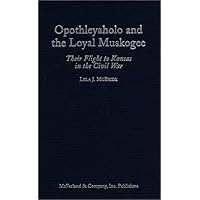
Average Reviews:

(More customer reviews)A few years ago, the United States Postal Service issued a stamp commemorating the Native American leader and rebel brigadier, Stand Watie. Watie became a minor hero in the Confederacy when he succeeded in driving the loyal native population out of what was then the "Indian Territory" into southern Kansas, bringing the Indian Territory safely, if temporarily, under Confederate control.
The primary victims of his campaign were the Creeks, or as they prefer to be called, the Muskogee, led by their elder, Opothleyaholo. Although we all know the Civil war as an event that brought brother against brother, I, for one, have never thought of it as an event that also divided Native Americans. Here, in this relatively slim volume, the author Lela McBride corrects that idea, and tells the story from the point of view of some of the native people who chose to stay with the Union.
Suffering came with a vengeance to the Muskogee in the late months of 1861, when they were forced on a second "trail of tears," northward across the plains from the Indian Territory that would later become Oklahoma into the relatively loyal area of Kansas. But their loyalty was hardly well rewarded. Driven from their homes in winter by the Cherokee, they were seen as unwelcome interlopers by the Kansans who had settled the area they fled to, and they were further stripped of staples and dignity by the Indian agents charged with their support. The author has done a very thorough job of researching her story. She provides the reader with a wealth of background information, while relating this overlooked Civil War story. Here you can read the full story of the proud Muskogee, and of yet another instance of Native Americans who supported our government and its cause, and who received scant reward in return.
Click Here to see more reviews about: Opothleyaholo and the Loyal Muskogee: Their Flight to Kansas in the Civil War
In 1861, Lt. William Averell was dispatched to Indian Territory on a secret mission intended to close the forts that protected the Creeks, Seminoles, Chickasaws, Choctaws, and Cherokees. The South immediately seized the opportunity to woo the Indian nations to the Confederacy. The South anticipated some trouble with John Ross, the Cherokee chief, but expected little difficulty from the other tribes. But they had forgotten about a leader of the Muskogees, called Creeks by the whites, named Opothleyaholo. Opothleyaholo had endured the "Trail of Tears" in 1836, when the Creek had been uprooted from their homelands in Alabama and Georgia and sent to Arkansas. Despite hardships, they eventually prospered in the new territory. As the Civil War approached, Opothleyaholo fully understood the strategic importance of the Indian Territory to the Confederacy and knew that an alliance with its government would undoubtedly lead to the demise of his people. Despite his distrust of the American government, which consistently broke their promises to the Indian nations, he sided with the United States and fought bravely, only to be deserted by its troops when he needed them most. Retreating to southern Kansas during the worst winter in memory, most of his followers-men, women, and children-died in Wilson County, Kansas, in 1862. This is the story of a little-remembered part of the years leading up to the Civil War and the bravery and misfortune of the Indian tribes in the conflict.

0 comments:
Post a Comment